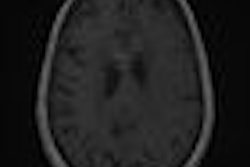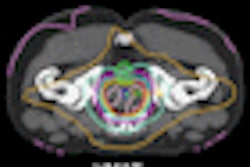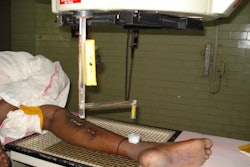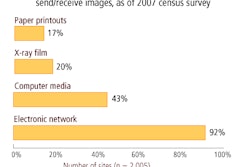Girls who received treatment for Hodgkin's disease between 1960 and 1990 and are now adult women have a 37-fold increased risk of developing breast cancer compared to the general population, according to U.S. researchers. The study, which followed the outcomes of 398 women over 6,323 person-years, also determined that these patients had a high likelihood of developing bilateral breast cancer at an early age.
Secondary breast cancer studies of large patient populations are infrequently undertaken because they are difficult to conduct. This is due to both the long latency period before breast cancer develops and the small number of Hodgkin's disease survivors diagnosed with breast cancer at any single medical institution.
The study is a subset of a larger one, reported earlier by AuntMinnie.com, that followed the outcomes of 930 male and female patients who were diagnosed and treated for pediatric Hodgkin's disease during pubertal years. The breast cancer study was published in the International Journal of Radiation Oncology, Biology, Physics (September 1, 2008, Vol. 72:1, pp. 34-40).
Both studies represent the combined work of Children's Hospital Boston and the Dana-Farber Cancer Institute in Boston; Johns Hopkins' Sidney Kimmel Cancer Center in Baltimore; St. Jude Children's Research Hospital in Memphis, TN; the University of Florida Medical Center in Gainesville; and the University of Rochester Medical Center in Rochester, NY. The institutions undertook this study to define demographic and therapeutic associations with the risk of breast cancer and use the resultant data to formulate screening strategies and support modification of current therapies for pediatric Hodgkin's disease.
All girls younger than age 18 at time of diagnosis who received treatment at one of the hospitals between 1960 and 1990 were enrolled, as long as they did not have a prior history of cancer. The mean age at diagnosis of Hodgkin's disease was 14.5 years, and the mean follow-up was 16.9 years, although some patients were followed for up to 37 years. Of the 398 patients, 253 patients had early-stage (stages I and II) Hodgkin's disease, and 145 had advanced-stage (stages III and IV) disease.
Of the patient cohort, 44% were treated with radiation therapy, 9% with chemotherapy, and 47% with a combination of radiation and chemotherapy. Most of the patients received mantle radiation, and 62.3% of all patients received a mantle radiation dose of at least 35 Gy. The mean age of diagnosis, racial/ethnic composition, treatment modality, histological distribution of Hodgkin's disease, rates of splenectomy and relapse, and chemotherapy scores were similar among patients with breast cancer and those without.
Seven percent of the cohort, or 29 women, were diagnosed with breast cancer (25 invasive and four ductal carcinoma in situ) at a median age of 31.4 years.
Two factors significantly associated with breast cancer patients were diagnosis of early-stage Hodgkin's disease and higher doses of mantle radiation. The researchers suggest that early-stage Hodgkin's disease patients were more likely to have been treated with radiation alone (59.3% versus 16.6%) and higher doses of mantle radiation (36.4 Gy) than advanced-stage patients (30.2 Gy).
Hodgkin's disease survivors face a high risk of developing breast cancer in both breasts, according to the researchers. Bilateral disease was present in 10 of the 29 women. The interval for developing contralateral breast cancer was 12 to 34 months, with a mean of 23 months. Invasive ductal carcinoma was the most common histology.
The study results indicate an unexpectedly steep dose-response relationship between radiation dose and the occurrence of breast cancer. Of the patients diagnosed with breast cancer, 34% subsequently developed bilateral cancer, whereas the general population risk for bilateral breast cancer is approximately 3%.
Previously published clinical studies have suggested that proliferating breast tissue at adolescence may be more susceptible to malignant transformation from exposure to radiation, and the fact that there was a higher risk for girls older than 12 supports this theory.
Of the 398 patients, 98 received pelvic radiation, which conferred a protective effect against breast cancer, presumably due to ablation of ovarian function. This suggests that the influence of estrogen during adolescence may be similar to that seen in the general population, according to the researchers. Pelvic irradiation would never be suggested for such women as a prophylactic measure, Dr. Louis Constine, a radiation oncologist at the University of Rochester Medical Center, clarified in an e-mail to AuntMinnie.com.
Since 1990, great strides have been made to improve and refine treatment of Hodgkin's disease, with use of lower doses of radiation therapy and more avoidance of breast tissue with the radiation field. These advances may reduce the incidence of breast cancer as patients of the past 20 years mature.
However, based on their findings that breast cancer developed as early as 9.4 years after treatment, the researchers recommend that breast cancer screening be initiated at a similar time interval after Hodgkin's disease treatment is concluded. These findings reinforce the March 2007 guidelines of the American Cancer Society (ACS) recommending that Hodgkin's disease survivors have annual breast MRI screening.
The researchers also recommend that additional multi-institutional studies be conducted to determine if treatment protocol changes introduced after 1990 reduce the incidence of breast cancer, and if a biological difference can be identified in patients with early-stage Hodgkin's disease that predisposes them to developing breast cancer.
By Cynthia Keen
AuntMinnie.com staff writer
December 30, 2008
Related Reading
Female Hodgkin's survivors have greater risk of secondary cancer, October 28, 2008
Second-cancer risk from Hodgkin therapy seen reduced substantially, January 17, 2008
Childhood cancer survivors have increased risk of developing new malignancies, December 31, 2007
Kids face more problems after beating cancer, July 15, 2004
Copyright © 2008 AuntMinnie.com



















